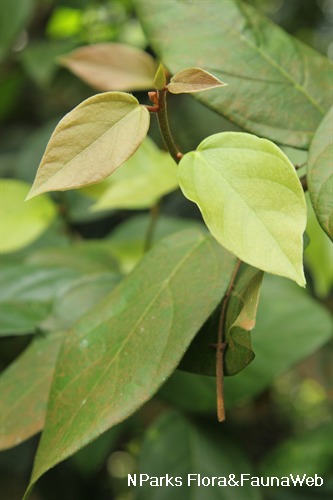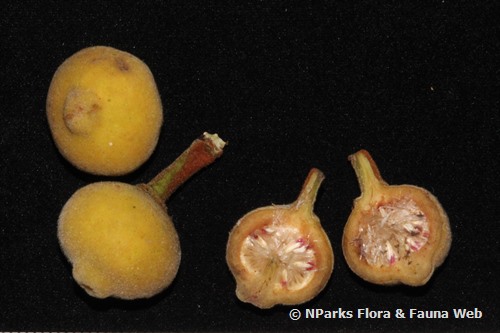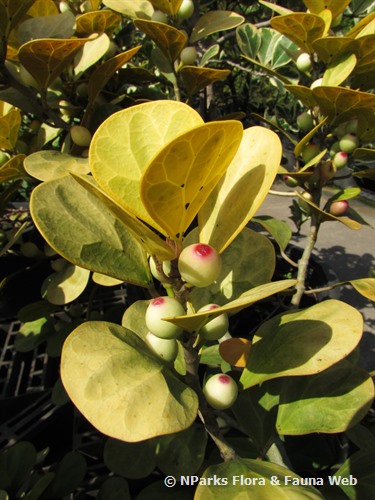
Name
Classifications and Characteristics
| Plant Division | Angiosperms (Flowering Seed Plants) (Dicotyledon) |
|---|---|
| Plant Growth Form | Climber |
| Lifespan (in Singapore) | Perennial |
| Mode of Nutrition | Autotrophic |
| Plant Shape | Irregular |
Biogeography
| Native Distribution | Indochina, Thailand, Sumatra, Peninsular Malaysia, Singapore, the Philippines, Borneo, Java, the Lesser Sunda Islands, and the Moluccas |
|---|---|
| Native Habitat | Terrestrial (Primary Rainforest, Secondary Rainforest, Freshwater Swamp Forest) |
| Preferred Climate Zone | Tropical |
| Local Conservation Status | Native to Singapore (Critically Endangered (CR)) |
Description and Ethnobotany
| Growth Form | It is a latex-containing, root climber, with red stems and leaf stalks that are covered with hair. |
|---|---|
| Foliage | Its spirally arranged, stalked leaves have leathery blades that are covered with red hair on both surfaces or only its undersides, 3–17 by 3–10 cm, and with slightly pointed tips. |
| Flowers | The plant is dioecious with each plant bearing male or female flowers. The flowers are tiny and develop within the syconium (fig). |
| Fruit | Its short-stalked syconia (figs) are almost round, up to 2 cm wide, wine-red when ripe, densely covered with short, brown hairs, and occur singly or in pairs in the leaf axils. |
| Habitat | It grows in hill to lowland forests up to 1,300 m altitude. It occurs locally in Mandai Forest and Nee Soon Swamp Forest. |
| Associated Fauna | Its flowers are pollinated by fig wasps. The ripe figs are eaten by birds. |
| Cultivation | It can be propagated by seed and stem cuttings. |
| Etymology | Latin Ficus, the commercial edible fig (Ficus carica); Latin trichocarpa, hairy fruits, referring to this species’ hairy figs |
Landscaping Features
| Landscaping | It has red figs and leaf stalks that are covered with hair. It may be suitable for gardens or parks. |
|---|---|
| Desirable Plant Features | Ornamental Foliage, Ornamental Fruits |
| Landscape Uses | General, Parks & Gardens, Small Gardens, Reforestation |
| Thematic Landscaping | Naturalistic Garden, Bird & Wildlife Garden |
Fauna, Pollination and Dispersal
| Fauna Pollination Dispersal Associated Fauna | Bird-Attracting |
|---|---|
| Pollination Method(s) | Biotic (Fauna) |
| Seed or Spore Dispersal | Biotic (Fauna) |
Plant Care and Propagation
| Light Preference | Semi-Shade |
|---|---|
| Water Preference | Moderate Water |
| Plant Growth Rate | Moderate |
| Rootzone Tolerance | Moist Soils, Well-Drained Soils, Fertile Loamy Soils |
| Propagation Method | Seed, Stem Cutting |
Foliar
| Foliage Retention | Evergreen |
|---|---|
| Mature Foliage Colour(s) | Green |
| Mature Foliage Texture(s) | Hairy / Hirsute |
| Prominent Young Flush Colour(s) | Red |
| Young Flush Texture(s) | Hairy / Hirsute |
| Foliar Type | Simple / Unifoliate |
| Foliar Arrangement Along Stem | Alternate |
| Foliar Attachment to Stem | Petiolate |
| Foliar Shape(s) | Non-Palm Foliage (Elliptical) |
| Foliar Venation | Pinnate / Net |
| Foliar Margin | Entire |
| Foliar Apex - Tip | Acuminate |
| Foliar Base | Rounded / Obtuse, Cordate |
Floral (Angiosperm)
| Flower & Plant Sexuality | Unisexual Flowers , Dioecious |
| Flower Grouping | Cluster / Inflorescence |
|---|
| Inflorescence Type | Syconium |
Fruit, Seed and Spore
| Mature Fruit Colour(s) | Red |
|---|---|
| Fruit Classification | Multiple Fruit |
| Fruit Type | Fleshy Fruit , Accessory / False Fruit (Pseudocarp) |
Image Repository
Others
| Master ID | 31300 |
|---|---|
| Species ID | 5697 |
| Flora Disclaimer | The information in this website has been compiled from reliable sources, such as reference works on medicinal plants. It is not a substitute for medical advice or treatment and NParks does not purport to provide any medical advice. Readers should always consult his/her physician before using or consuming a plant for medicinal purposes. |








